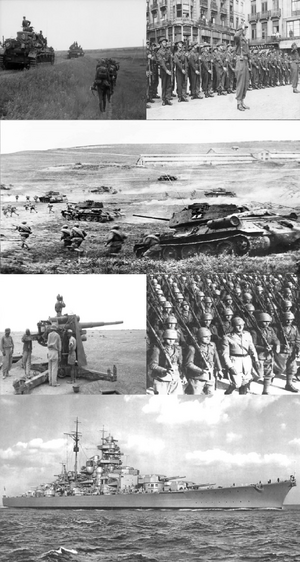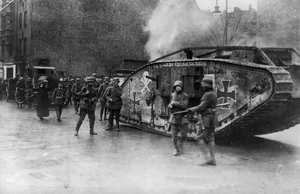Corentian Campaign (Sunalayan Second Great War)
This article is incomplete because it is pending further input from participants, or it is a work-in-progress by one author. Please comment on this article's talk page to share your input, comments and questions. Note: To contribute to this article, you may need to seek help from the author(s) of this page. |
| Corentian Campaign | |||||||
|---|---|---|---|---|---|---|---|
| Part of the Second Great War | |||||||
 From Left to Right: Englean Heer troops advancing into Damsmar, Rhodeve Protectorate Program soldiers, Libriran combined forces counter-attacking Damsmarian positions, Englean FlaK 36 in the Trident Desert, Damsmarian soldiers, and Kaiser class undergoing sea trials. | |||||||
| |||||||
| Belligerents | |||||||
| Commanders and leaders | |||||||
|
|
| ||||||
The Corentian Campaign of the Second Great War took place from ? Oct (?) 19?? to ? Aug(?) 194?. It included campaigns fought in Sunrisia, Librira, the Englean Kaiserreich, and Daredland. This campaign was fought between the Corentian forces of the Dronden Pact (Librira, the Englean Kaiserreich, Talvistova), non-Corentian forces of the Pact (Rhodevus, Aznazia), and the forces of the Core (Damsmar and the Frasian Federation).
Background
Damsmarian Empire
Englean Kaiserreich
Following what was seen as a victory in the Corentian Campaign of the First Great War, the Kaiserreich had focused throughout the following decades on further industrial and infrastructural improvements rather than military buildup. At this time, the Kaiserliche-Marine became the most powerful branch of the Englean GKSeK due to the Kaiserliche Heer lacking enough action in the First Great War to justify increases in funding. Following the war it was believed that the next major war involving the Kaiserreich would involve much more action at sea, rather than on the land in Corentia. This process in thinking allowed the Damsmarian Empire to grow in strength in comparison to the Kaiserreich, leaving the latter nation significantly susceptible to invasion.
In addition to this, the hurricane season of 193? was a particularly active one.
The decades following the First Great War saw the rise of hostile ideologies that threatened the stability of the monarchial government that the Kaiserreich had possessed since its inception in 875. Ideologies such as republicanism, socialism, communism, and fascism threatened to pull support from those suffering from the 1929 Economic Depression as it had done in many nations around the world. The Imperial Government attempted to produce new legislation to bring back support from these groups, but many failed to live up to expectations and instead brought more hostility from the lower classes.
This hostility was brought to a boiling point after the Stühshafen Incident of 1933, when soldiers of the Royal Sachsen Landwehr opened fire on protesting Frasian citizens after one soldier believed to hear a gunshot. This event marked the formal declaration of succession of the Frasian Federation from the Englean Kasierreich in 1933.
Frasian Federation
Librira
Talvistova
The Rhodeve Protectorate Program
The Rhodeve Protectorate Program (RPP) was created in 1937 between Rhodevus, Ispanza, Eubatu and Lylhorion, as a mutual protection and economic aid treaty between Rhodevus and the smaller nations in order to alleviate the continuing pain caused by the ongoing Great Recession. As tensions in Corentia increased with the continual build-up of military forces between the major players on the continent, a greater amount of focused was placed on the military portion of the RPP, concluding with the signing of the Combined RPP Military Agreement, which lead to the joint organization of all RPP militaries into a single unified force to allow for easier lines of communication and direction.
New training centres were commissioned in 1938 and 1939 in Ispanza, with plans to construct a new dry dock in Eubatu in 1941.
Rhodevus
Following success in the First Great War, Rhodeve efforts during the 1920s turned to consumer products and expanding upon the efforts made to establish an independent and uniquely Rhodeve naval force. Efforts throughout the 1920s and into the Great Recession of the 1930s were met with multiple disasters.
Largescale roadwork projects and national monuments, dams and aquafers would help to put Rhodeves back to work.
Ispanza
Ispanza, having newly gained full independence in 1920 from Rhodevus would explode economically, as work following the Great War reached an all-time high in order to build and rebuild the nation. Starting from 15 islands in 1917, the April Sale in 1921 and islands gifted to Ispanza by Engleberg in 1923 and the July Sale in 1926 would allow the island country to actively increase their fishing, farming and mining sectors.
The Great Recession hit Ispanza in 1930 as it did many other countries, but due to it's young history, it was less effected overall, being still able to go through with the Great Recession Deal in 1933 which allowed for the purchase of more islands from Engleberg.
Referendums held on each inhabited island would eventually lead to Ispanza's population rapidly expanding, as Halei'i Ke'ahi Ole'ai, Hua Ka'ua, Kawai'i, Leili'i, Pihai'a, and Kihipai all voted to join the confederation of Ispanza in 1921, 1930, 1930, 1933, 1937, 1938 and 1921 respectively.
Eubatu
Remaining neutral in The First Great War allowed Eubatu to maintain its population and work to modernize and urbanize. The Battle of Pearl Coast in April 21, 1918 left the nation with a fleet of battleships which would allow the nation to maintain national security during the post-war period, up into the 1930s. Eubatu reached its peak population of 2.5 million in 1936; the largest the population would reach even until today.
Damsmarian Invasions
they failed
